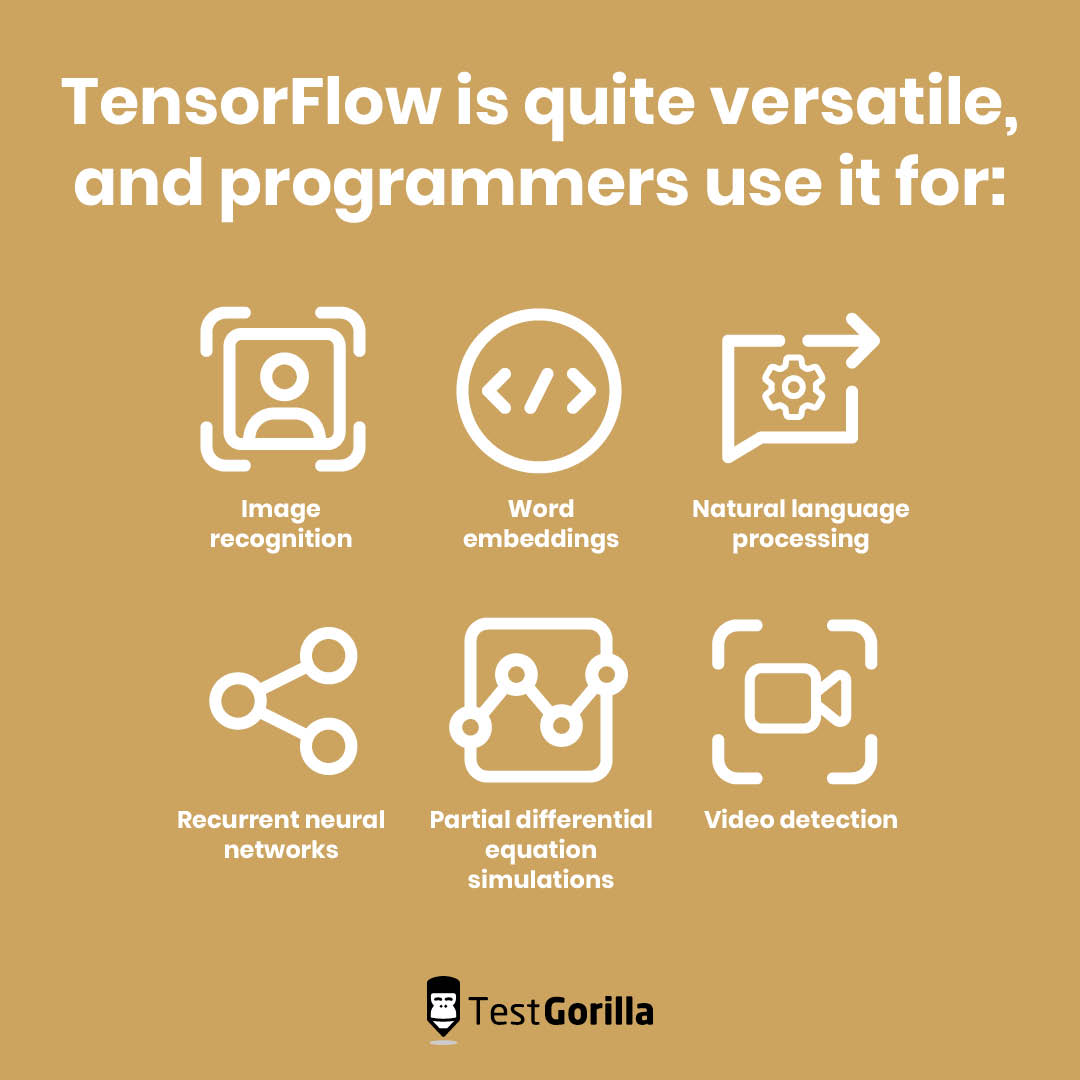Keras and TensorFlow are frameworks used for deep learning. A framework is a collection of libraries and packages that help software developers code applications easier.
TensorFlow and Keras are two of the most popular deep learning frameworks available today.
This article will help you understand how these two frameworks are differen, when you should use one or the other, or how a pre-employment test like our Keras test can help you hire the right developers for your organization
Table of contents
What is Keras?
Keras is a high-level deep learning API. It was released in 2015 and has since become one of programmers’ favorite frameworks for implementing neural networks.
Why did Keras become so popular?
For starters, the complexity of many frameworks has been a strong barrier to entry for many data scientists, programmers, and machine learning engineers. Everyone wanted a framework that was simple to use but retained the elements that enable engineers to build large neural networks and models.
Keras was the answer to that – it’s a simple framework that still offers the high-level features machine learning engineers need to develop advanced models.
This open-source library was developed by François Chollet, an engineer at Google. Its main advantages are that it’s fast, easy to implement, and modular in nature.
Keras was built using the Python programming language, so many programmers who are familiar with Python have an easier time learning the framework’s functionalities.
The Keras software library was created to act as an interface for other frameworks, such as Theano and TensorFlow.
What is TensorFlow?
TensorFlow is the most popular deep learning framework. It was created by the Google Brain team at Google. Scientists who work on deep learning software use TensorFlow to create different models and algorithms. The open-source library enables them to carry out complex numerical computations and create supervised and unsupervised learning algorithms.
Large datasets are the staple of TensorFlow; it clusters massive datasets (machine learning and deep learning models) to create outcomes on their own.
Programmers can use this library with several languages, including Python, C++, and Java. TensorFlow’s primary purpose is to train machine learning models to make fast decisions based on large datasets.
TensorFlow is quite versatile, and programmers use it for a variety of tasks, such as:
Image recognition, which requires quick decisions to be made based on a massive amount of data
Word embeddings
Natural language processing, which involves teaching models to decode and understand human language
Recurrent neural networks
Partial differential equation simulations
Video detection – even NASA uses TensorFlow to model asteroids’ trajectories in space
Since TensorFlow can quickly crunch many data points, it’s even been used in sales analytics to provide insights and predict future outcomes.
Many programmers prefer TensorFlow because its flexible functions enable them to easily build models, implement and deploy them anywhere, and conduct experimentation for research purposes.
Which is better: Keras or Tensorflow?
Even though Keras runs on top of TensorFlow, comparing the two frameworks is pretty difficult. This is because developers use them for different purposes.
However, the frameworks differ in the following areas:
Difficulty level. Keras was developed to be relatively easy to use. In contrast, TensorFlow has a steep learning curve and is quite difficult to use and master.
Usage. Keras is a neural network library, whereas TensorFlow is an open-source library for a variety of machine learning tasks. This means that programmers use the two frameworks to accomplish different tasks.
API level. Keras is a high-level API. However, thanks to its versatility, the TensorFlow API offers both high- and low-level functionalities.
Ease of access. Because Keras is easy to use, it’s ideal for small datasets with fewer computational needs and low-performance models. On the other hand, TensorFlow has a complex architecture and a difficult debugging process, so it’s mainly used for large datasets with high-performance models.
Deeper options. Keras is built to be fast and easy to use, so it’s not as well equipped as TensorFlow when it comes to more advanced features.
You’ll need skilled programmers to use Keras and TensorFlow
Once you determine which framework better suits your business needs, you will need to find a programmer who can work in that framework. Start by writing a great job description for TensorFlow developers or Keras developers.
To do so, you should use a pre-employment test in your hiring process. TestGorilla’s skills tests, like the Keras test, can help you easily assess your applicants’ abilities.
Using a pre-employment test in your recruitment process has many benefits:
It’s easy and simple to use. You can send the test to all your candidates with a single click and just wait for the results to come in. The test results are numerical so that you can compare applicants with ease.
You don’t have to rely on CV screening anymore. When you do CV screening, you’re basically assessing how well candidates can write resumes. But with a prescreening test, you can assess the skills candidates will actually use on a daily basis.
It’s bias-free. By using a skills test, you will eliminate bias from the hiring process. Every applicant will receive the same test and have an opportunity to prove their skills by completing it.
So whether you choose Keras or TensorFlow for your company, make sure that you have the right people operating the framework.
Sign up for TestGorilla today, and start finding them with our pre-employment tests.
Related posts
Hire the best candidates with TestGorilla
Create pre-employment assessments in minutes to screen candidates, save time, and hire the best talent.
Latest posts
The best advice in pre-employment testing, in your inbox.
No spam. Unsubscribe at any time.

Hire the best. No bias. No stress.
Our screening tests identify the best candidates and make your hiring decisions faster, easier, and bias-free.
Free resources
This checklist covers key features you should look for when choosing a skills testing platform
This resource will help you develop an onboarding checklist for new hires.
How to assess your candidates' attention to detail.
Learn how to get human resources certified through HRCI or SHRM.
Learn how you can improve the level of talent at your company.
Learn how CapitalT reduced hiring bias with online skills assessments.
Learn how to make the resume process more efficient and more effective.
Improve your hiring strategy with these 7 critical recruitment metrics.
Learn how Sukhi decreased time spent reviewing resumes by 83%!
Hire more efficiently with these hacks that 99% of recruiters aren't using.
Make a business case for diversity and inclusion initiatives with this data.





















